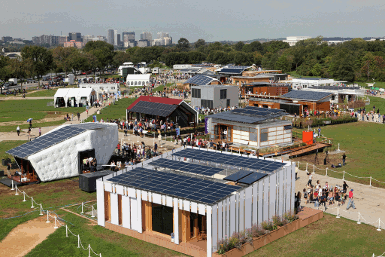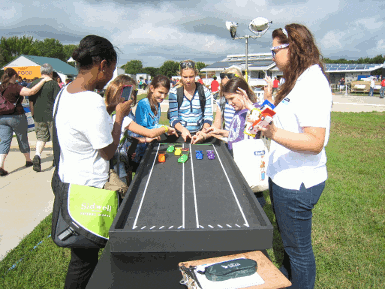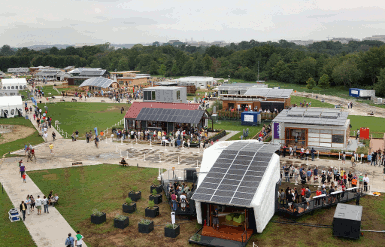Solar Decathlon Competition inspires new Green Home Designs

Green House Designs at the Solar Decathlon in Washington.
Photo courtesy of Stefano Paltera/U.S. Department of Energy Solar Decathlon. Click for a larger version which will open in a new page.
The Solar Decathlon is an interesting and exciting competition in the USA where teams of college and university students compete to design the most attractive, effective and efficient solar house. It is the brainchild of the program manager of photovoltaics at the USA Department of Energy, Richard King. He has been involved not only in the research and development side of things but also in trying to think about what will stimulate the public's interest in using energy more efficiently. One night he and his wife, Melissa, were talking about the various ways that solar energy powers our lives or ways that it could. They started counting on their fingers and came up with 10 ways and suddenly they decided that a competition called the Solar Decathalon would be a good idea. They named it without even knowing it would come into existence.
Richard pitched the idea to several people at America's National Renewable Energy Laboratory, previously known as the Solar Energy Research Institute, and formed back in the late 1970s by an act of congress. As a national laboratory they get most of their funding from the US Department of Energy. They research all fields of green and renewable energy, including photovoltaics, which is the direct conversion of sunlight to electricity in solar cells. The National Renewable Energy Laboratory decided that a Solar Decathlon was a fabulous idea to try to get college students involved and interested in the topic of solar energy. The idea that they had was to try to make the competition interesting enough that people would come to see it, so that meant actually building something rather than just designing it, and thus the solar decathalon was born. The 10 contests that were held during the first competition in 2002 demonstrated all aspects of the energy that people use in their lives, from heating, lighting and cooling in the home to running an electric car, because transportation is a big part of our domestic energy needs. Students were required to do laundry, cook and entertain - evey aspect of daily lives was powered by the sun in this competition.

Middle school students racing solar cars at the Solar Decathlon's Education Day.
Photo courtesy of Richard King/U.S. Department of Energy. Click to open a full-sized version in a new page.
They also thought that solar energy was not only functional but beautiful, so part of the competition centers around the aesthitic value of the solar powered home. What is remarkable and has evolved since the first event in 2002 is that there are a virtualy infinite number of solutions to the problem of how to design and build a beautiful solar powered home, not just one single correct way to to it. With transportation they found that design iterated to a single solution of a certain shape and size, and a way to deploy photovoltaic cells on the car seemed to emerge, but with houses they continue to see a huge variety of designs, all of which solve the problem of how to use solar energy to power people's lives.
Cecile Warner, a project manager at the US Department of Energy's National Renewable Energy Laboratory, has led the laboratory in developing and managing the highly acclaimed Solar Decathlon. Winner of the Women in Solar Energy award from the American Solar Energy society for her contributions, particularly her public outreach efforts, Cecile says that the most astonishing thing about this is you have to keep reminding yourself when you see the beautiful homes that are built and operating on the National Mall in Washington during the competition is that these constructions are most likely to be the very first ever design that the builders have made, and their average age is that of a college student, in other words around 20 years old. Even more impressive is that they have to build to a certain schedule. Anyone who has ever built a house for themselves knows that meeting a schedule that you set out for yourself is quite a challenge, with the difficulties in organising all of the trades people invloved to meet deadlines, combined with delays caused by bad weather and other problems. Even in the commercial building environment, meeting schedules is never an easy thing to do. The fact that these these students not only transport their designs to the mall but also build them and operate them, and that this has to be done by all the students in the same week means that around the clock dedication is required. Most people probably wouldn't work that hard even if you paid them very princely sums!

Ariel view of Green Homes at the Solar Decathlon Competition in Washington.
Photo courtesy of Stefano Paltera/U.S. Department of Energy Solar Decathlon. Click to open a full-sized version of this picture in a new page.
In the first competition which was held in 2002 the teams were given only $5,000 of seed money and they were required to raise all of the rest of the capital to build their projects and get donated materials on their own. Fortunately the contest has been very lucky to have attracted the enthusiasm of the United States Department of Energy to the point where the teams now have a research and development component to work on building integrated photovoltaics in their projects and the competition organisers have been able to increase the seed money to $100,000 per team as at 2012. This is still nowhere near what these projects cost, as they are hand crafted uniqued designs, built with high technology elements.
Most of the students involved are very enthusiastic about the environment, the future of the planet and the limited resources of energy and other attributes of homes. The contest organisers have seen the deployment of fascinating new materials like aerogel, which is a translucent material which provides insulation whilst being able to let light to pass through it. This can be used as a hybrid between a window and a wall. There have been interesting deployments of lighting and complex control systems which allow the house to adjust itself to what the environment is doing. Then of course there are the solar cells which provide the energy for all of the activities. All of this is in addition to low technology natural ecologically friendly materials which all go together to make a truly green home.

- Renewable Energy:
- Login to post comments
